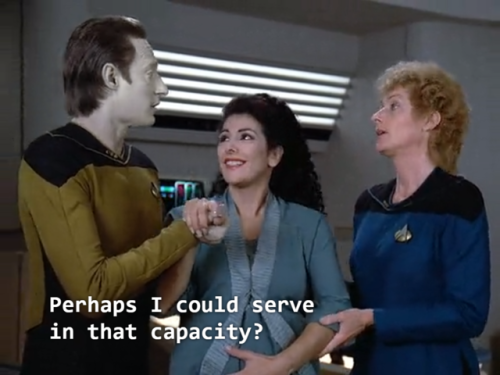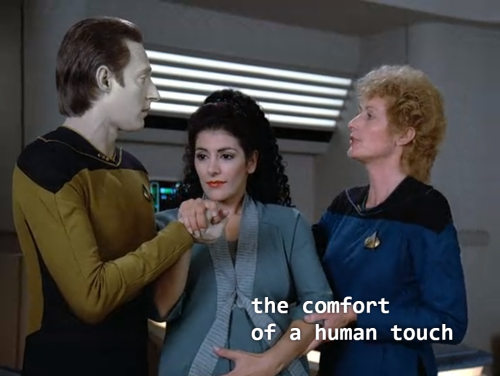aqueerkettleofish:earhartsease:gholateg:gayahithwen:mummified-priest:prismatic-bell: elfwreck:cann
aqueerkettleofish:earhartsease:gholateg:gayahithwen:mummified-priest:prismatic-bell: elfwreck: cannon-fannon: thatoldantique: linguisticparadox: deannatroibolton: You ever invite your coworker to watch you give birth just to spite a racist Okay howmst the fuck has a ship doctor in the far future never handled a birth without the father present? Are sperm donors and gay couples and trans women no longer a thing in the bajillionth century CE?? :/ I while understand the frustration with erasure sometimes it helps to look at things through the cultural context of when something was made. Star Trek the Next Generation was made in 1987, this particular episode I believe aired in 1988 a time when a future where the husband was always present for the birth would have been amazing to many of the people watching the show as men had only been allowed to be present for the birth of their children for 10/15ish years at that point in the US. Women (and many men) fought for decades with hospitals to even have men allowed in the delivery room during the early stages of labor, which can last for several hours, and hospitals only began to give in to their requests in the 1960s but even then they would be kicked out of the room by hospital staff before the actual birth took place. So many of the couples watching the show would have had to go through labor without having/being allowed to support their spouse regardless of their wishes. Having the child’s father present for the birth only began to happen in the 1970s and 1980s. Which means most people watching this show either went through birth without the support of their spouse, were not allowed to support their spouse during the birth of their child, or their own mother’s went through that during their birth. A future where the husbands were always present for the birth was still a little crazy to consider in the late 1980s. A good kind of crazy for the people living in that time, it showed a future where the wishes of the couple were finally consistently listened to by medical professionals as a result of the actions of people during their or their parent’s lifetimes. And it does that by also subverting it in allowing Data to step into the role of the father when the father was unknown and/or unwilling/unable to fill that role (I’ll be honest my knowledge of Next Gen is a bit spotty and I have not seen this whole episode, just a piece of it at family Thanksgiving). The woman’s desires as to how she would give birth are listened to and respected, something that still doesn’t happen in many hospitals now and would have been seen as even more revolutionary then. So while it isn’t perfect I think this scene was actually fairly impressive for its time and cultural context and shows a future that many people of that time would have seen as ideal. I think this kind of contextual understanding and analysis is really important because things that look antiquated now were revolutionary then. I remember reading that the mini skirts in Star Trek TOS were legot just in fashion (about 64’ ish), one of the actresses (the one that played Rand) requested they be in the show and both her and Nichelle Nichols said they didn’t see them as demeaning but liberating in that time and context. Where as NOW it looks like ‘sexy male gaze’ but then it wasn’t. Miniskirts are comfortable and easy to move in - unlike longer bulkier skirts, which had previously been required for “modesty.” And unlike the approach of “we’ll just put them in pants,” miniskirts made a statement that women crew-members weren’t being treated like men. Miniskirts were a way to say “I can be an attractive woman, wear comfortable clothes, and still look professional and do a serious job.” The clothing for that message today would be different. This is also why the bridge crew of TOS may seem “tokenistic” today. When it came out, the Cold War was in full swing and “Soviets” were maligned and hated, Black people could not count on their right to vote being honored, and mixed-race people (like Spock) were called horrible things like “half-breed” and “zebra.” A white man was in charge of the ship, but Gene Roddenberry was fully aware that a chunk of the viewership read him as queer, and did ABSOLUTELY NOTHING TO DISCOURAGE THAT READING, at a time when “homosexual activity” was illegal in the United States! By today’s standards, “one of everything? How tokenistic.” In 1966? “A Black woman, a Russian, a man from multiple cultures, and a man who loves differently, all top of their fields, all working together and finding common ground to learn, grow, and help where they can? What a wonderful future!” Also I’m sorry but like. A show also featuring a Japanese man who isn’t a stereotype but part of the crew, having a Scottish character be a part of the central cast (idk if I need to get into why this is important, but considering how England has continuously tried to erase Scottish culture and identity, and the stereotype of Scots as bumbling bumpkins, etc, its kind of nice to see a Scotsman who’s the best of the best at his job). Moreover, a lot of kids watched this show. MLK himself contacted Nichelle Nichols and asked her to stay on the show when she was considering leaving, because “you don’t have a Black role, you have an equal role,” and there wasnt many Black role models on tv. I can only imagine how Black kids, Asian kids, and mixed race or mixed culture kids felt seeing people like them on tv. Hell, seeing Uhura on screen is what inspired Whoopi Goldberg as a little girl. Also, yeah, its easy to look back and say ‘damn, fathers weren’t there in the delivery room? What assholes’ but no like they legitimately were not allowed in there. Tiny correction: while George Takei is Japanese, and while Sulu thus looks like what we in the 20th-21st century consider to be an ethnically Japanese man, Hikaru Sulu was Pan-Asian by design. His last name is not Japanese. And Roddenberry designed him like that intentionally, because while there was a lot of anti-Japanese sentiment in the US at the time (I mean, hell… George Takei himself spent years in Japanese internment camps during WW2), there was also a lot of other anti-Asian sentiments, and Roddenberry intentionally put ALL of it on the character of Sulu.Like, all the years of anti-Chinese racism in the US? Sulu. Anti-Japanese sentiments left over after WW2? Sulu. Korean War in 1950-52? Sulu. The Vietnam War, with Johnson in 1965 (a year before TOS started airing) choosing to start sending American troops into the conflict? Sulu.Sulu was Roddenberry’s desperate attempt to show all Asian people as inherently worthy, inherently human, and yeah, he probably put kind of too much on Sulu’s shoulders, but it was the 1960s and Roddenberry fucking cared about representation, so he did what he could.Just, you know… a little bit more historical Star Trek context Also to hammer this home? Scotty was third in line for the captain’s chair. The only non-Kirk who had the con more then him was Spock. He was smart, he was a *ranked* crewmen, he was a gentleman, he wasn’t a skirt chaser, and he was capitol L loyal. The only time he got into a fight was when someone both went after his Captain, AND his Ship. And he was Scottish. That’s so above and beyond the typical Scottish stereotype even TO THIS DAY. Dr Polaski was coded as something of an arse just so they could make their valid points about equality and bigotry using her as a foil. Yes it was kind of clumsy from a modern perspective, but it was also kind of groundbreaking (not least because you didn’t usually get arses being played by women) I am hard-coded to put this on any post that mentions MLK and Nichelle Nichols.Also, it’s very worth noting that the “token minority character” label doesn’t apply in any way to these characters. Tokens are there to present the appearance of diversity. Whereas Roddenberry created a diverse cast in an era where there wasn’t even a need for the appearance of diversity. Roddenberry didn’t put these characters in because he wanted to look diverse– he put them in to BE DIVERSE. -- source link






